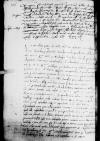List #1542
[Ioannes DANTISCUS] do [Mauritius FERBER]Löbau (Lubawa), 1536-09-19
Rękopiśmienne podstawy źródłowe:
Pomocnicze podstawy źródłowe:
Publikacje:
| ||||||||||||||
Tekst + aparat krytyczny + komentarz Zwykły tekst Tekst + komentarz Tekst + aparat krytyczny Ekscerpty dotyczące podróży Dantyszka
Reverendissime in Christo Pater ms. ri(!) ⌈erer ms. ri(!) ⌉ et Domine, domine mi observandissime. Salutem et mei commendationem plurimam.
Tandem mihi paulo ante redditae sunt hidden by binding⌈[nt]nt hidden by binding⌉ oratoris
Scripsit mihi rediens a Dominatione Vestra Reverendissima dominus
Quod reliquum est, me pate hidden by binding⌈[ate]ate hidden by binding⌉rnae benevolentiae Dominationis Vestrae Reverendissimae commendo. Quam Dominus Deus quam diutissime nobis sospi hidden by binding⌈[ospi]ospi hidden by binding⌉tet prosperetque ms. prosperitque(!) ⌈prosperetqueprosperetque ms. prosperitque(!) ⌉ in omnibus.

 BCz, 244, p. 156
BCz, 244, p. 156